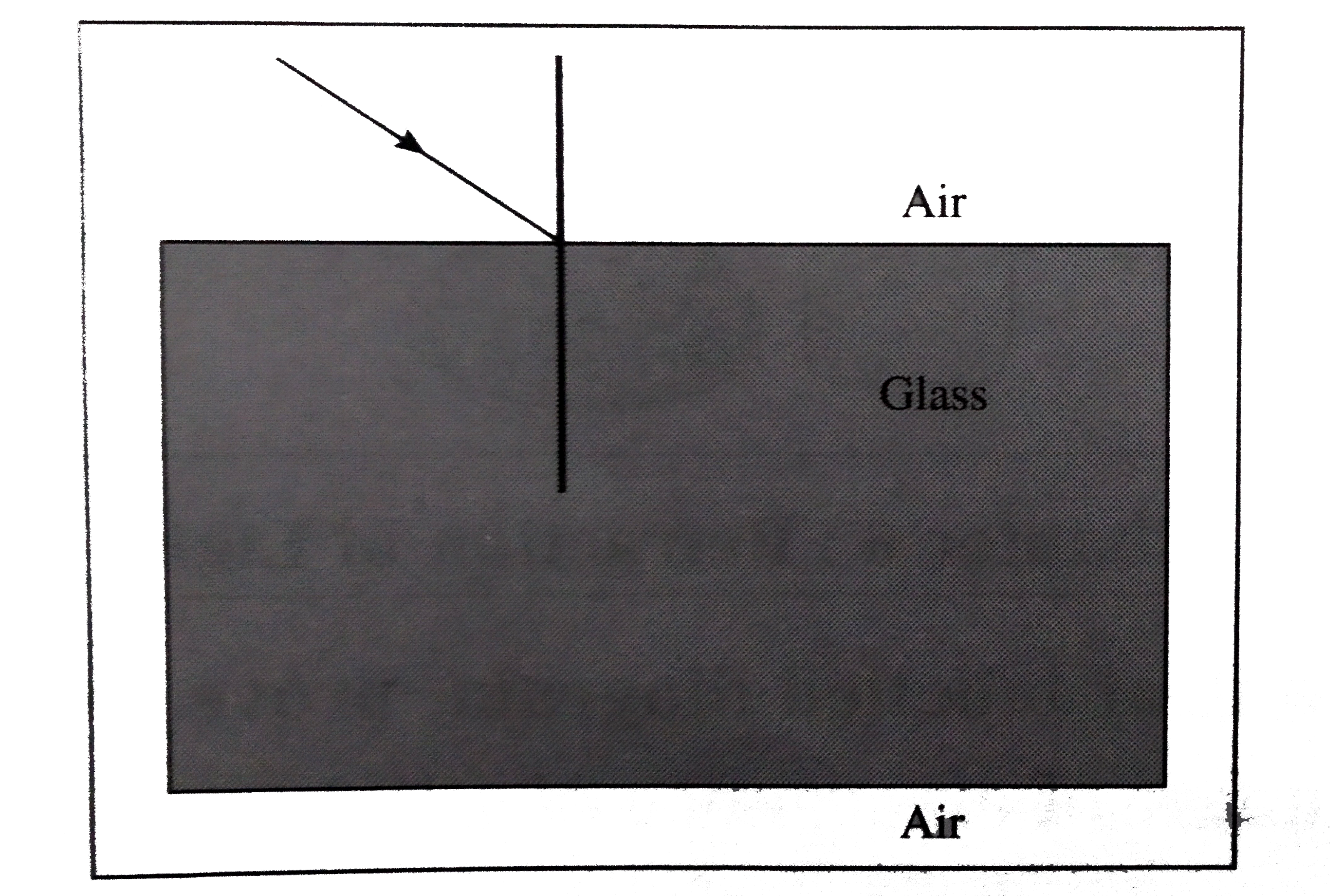When light is incident on a glass slab, the incident ray, refracted ray and the emergent ray are in three media A, B and C. If n1,n2 and n3 are the refractive indices of A, B and C respectively and the emergent ray is parallel to the incident ray, which of the following is true ?
n1<n2<n3
n1>n2>n3
n1<n2=n3
n1=n3<n2
To solve the problem, we need to analyze the situation where light passes through a glass slab and determine the relationship between the refractive indices of the three media involved.
1. Understanding the Setup:
- We have three media: Medium A (with refractive index n1), the glass slab (Medium B with refractive index n2), and Medium C (with refractive index n3).
- The incident ray enters Medium A, refracts through Medium B (the glass slab), and then emerges into Medium C.
2. Identifying the Condition:
- It is given that the emergent ray is parallel to the incident ray. This means that the angle of incidence in Medium A is equal to the angle of emergence in Medium C.
3. Applying Snell's Law:
- According to Snell's Law, when light passes from one medium to another, the relationship between the angles and refractive indices can be expressed as:
n1sin(θ1)=n2sin(θ2)(at the first interface)
n2sin(θ2)=n3sin(θ3)(at the second interface)
- Here, θ1 is the angle of incidence, θ2 is the angle of refraction in the glass slab, and θ3 is the angle of emergence.
4. Condition for Parallel Rays:
- For the emergent ray to be parallel to the incident ray, the angles must satisfy:
θ1=θ3
- This implies that the light does not bend when it exits the glass slab, meaning there is no net deviation.
5. Concluding the Relationship:
- Since the angles are equal and using Snell's Law at both interfaces, we can conclude that:
n1sin(θ1)=n2sin(θ2)andn2sin(θ2)=n3sin(θ1)
- For the angles to be equal, it must be that:
n1=n3
- Therefore, the refractive index of Medium A must equal the refractive index of Medium C.
6. Final Result:
- The correct conclusion is that:
n1=n3
- This means that the refractive indices of the media where the incident and emergent rays are located are equal.
- We have three media: Medium A (with refractive index n1), the glass slab (Medium B with refractive index n2), and Medium C (with refractive index n3).
- The incident ray enters Medium A, refracts through Medium B (the glass slab), and then emerges into Medium C.
- It is given that the emergent ray is parallel to the incident ray. This means that the angle of incidence in Medium A is equal to the angle of emergence in Medium C.
- According to Snell's Law, when light passes from one medium to another, the relationship between the angles and refractive indices can be expressed as:
n1sin(θ1)=n2sin(θ2)(at the first interface)
n2sin(θ2)=n3sin(θ3)(at the second interface)
- Here, θ1 is the angle of incidence, θ2 is the angle of refraction in the glass slab, and θ3 is the angle of emergence.
- For the emergent ray to be parallel to the incident ray, the angles must satisfy:
θ1=θ3
- This implies that the light does not bend when it exits the glass slab, meaning there is no net deviation.
- Since the angles are equal and using Snell's Law at both interfaces, we can conclude that:
n1sin(θ1)=n2sin(θ2)andn2sin(θ2)=n3sin(θ1)
- For the angles to be equal, it must be that:
n1=n3
- Therefore, the refractive index of Medium A must equal the refractive index of Medium C.
- The correct conclusion is that:
n1=n3
- This means that the refractive indices of the media where the incident and emergent rays are located are equal.
Topper's Solved these Questions
- QUESTION PAPER 2022 TERM 1 SET 2BOOK - X BOARDSCHAPTER - QUESTION PAPER 2022 TERM 1 SET 2EXERCISE - SECTION B
8 Videos
- QUESTION PAPER 2022 TERM 1 SET 2BOOK - X BOARDSCHAPTER - QUESTION PAPER 2022 TERM 1 SET 2EXERCISE - SECTION C
4 Videos
- QUESTION PAPER 2022 TERM 2 SET 1BOOK - X BOARDSCHAPTER - QUESTION PAPER 2022 TERM 2 SET 1EXERCISE - SECTION - C
4 Videos
Similar Questions
Knowledge Check
When rays of light are incident on a glass slab, then the incident ray and emergent ray are ……….. To each other.
AperpendicularBparallelCoppositeDconcurrentThe angle between the incident and the emergent ray from a glass slab is
A90∘B0∘Cless than 90∘Dmore than 90∘A ray of light passes through four transpar ent media with refractive indicesμ1,μ2,μ3 and μ4 as shown in figure. The surfaces of all media are parallel. If the emergent ray is parallel to the incident ray, we must hav
 Aμ1=μ2Bμ2=μ3Cμ3=μ4Dμ4=μ1
Aμ1=μ2Bμ2=μ3Cμ3=μ4Dμ4=μ1
Complete the following ray diagram to show refraction of light through a glass slab and label the incident ray, refracted ray and emergent ray.

View Solution'During refraction of light through the glass slab, incident ray and emergent ray are parallel to each other.' Explain.
View SolutionDuring refraction of light through the glass slab, incident ray and emergent ray are perpendicular to each other.
True/false
View SolutionThe angle between incident ray and reflected ray or refracted ray is called _____
View SolutionA ray of light passes through four transpar ent media with refractive indicesμ1,μ2,μ3 and μ4 as shown in figure. The surfaces of all media are parallel. If the emergent ray is parallel to the incident ray, we must hav

View Solution
